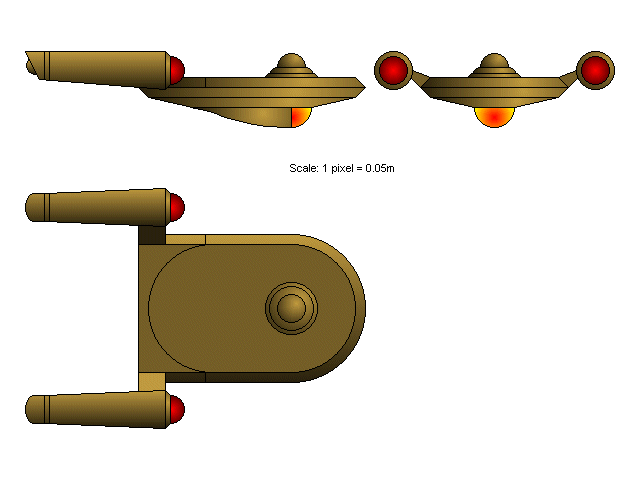
Designer: Robert C. Dunehew E-mail [email protected]

"Lancer" heavy fighter
General Specifications:
Length: 17.05m
Width: 12.05m
Height: 3.85m
Cruise: warp 6.5 (Mk I);
7.2 (Mk II);
7,5 (Mk III)
Burst speed: warp 7 (Mk I);
warp 8.1 (Mk II);
warp 8.5 (Mk III)
Max. Impulse: 0.75c (Mk I);
0.79c (Mk II);
0.805c (Mk III).
Crew: 2.
Armaments: One forward-firing light laser (Mk 1);
one forward-arc medium laser (Mk II);
one fwd-arc phaser turret (Mk III)
Type: Heavy fighter
Status: Entered production in 2249. 120 produced. Mark II introduced in 2257, previous Lancers were refit to Mk II specification, with an additional 140 produced. Mk III introduced in 2265. Mk II versions were refit to Mk III specification, and an additional 150 were produced.
About Ship: In 2245, Starfleet began reviewing its ship requirements. One of Starfleet's recommendations was the construction of small vessels to be used as scouts, short-ranged patrol vessels, and to provide ground support firepower. At the time, several diverse types of vessel were performing these tasks. Many of them were simple modifications of existing shuttle craft. These modified vessels were filling the role, but only just. Modified shuttles did not possess adequate firepower, shielding, or armor to be truly effective in these roles.
Starfleet Engineering designed a compact vessel which could be based aboard a carrier, a starbase, or a ground base. Since the vessel would have an endurance measured in only hours, the crew accommodations did not have to be as extensive -- one seat for each would do. The Lancer's crew pod was cramped, at 2 meters in diameter, but not overly so. It could be ejected in an emergency and used as a "life boat" capable of (one) atmospheric reentry. Endurance was right around six hours.
Three versions of the Lancer were produced while it remained in service. The Mark I was equipped with a single laser suitable for defensive purposes, capable of firing in a narrow forward arc. Cruise speed at warp was significantly greater than most vessels in the Starfleet inventory at the time, though burst speed* was somewhat less than the maximum emergency speed of most combat vessels fielded by Starfleet at that time.
The Mark II received an improved laser mounted in a turret, increasing the arc of fire. Additionally, its upgraded avionics systems included an improved sensor jamming system and greater sensor range. Improvements to the nacelle design and subtle recontouring of the spaceframe resulted in significant improvements in cruise and burst speeds. Impulse speed was significantly improved, as well. When the Mk II version was introduced, Mark Is were refit to the Mk II specification as resources became available. All Mk Is in service had been converted to Mk II specification by mid-2260.
The Mark III, introduced in 2265, was a significant improvement over the Mk II, including inproved sensors, uprated propulsion systems, extended endurance (eight hours, as opposed to six) and a phaser turret, as opposed to a laser turret. All Mk IIs were refit to Mk III configuration as resources became available, with the last Mk II converted to Mk III specification in late 2271.
The Lancer heavy fighter remained in service until well after the introduction of its replacement, the Goblin, in 2285. Lancers were transferred to reserve forces starting in 2287, with the last one leaving front-line service in 2293. The last Lancer was finally withdrawn from service in 2307. Four were retained by Starfleet Academy for maintenance training, while the remainder were converted to target drones. One example remains, and may be seen as a static display at the Starfleet Academy museum of Spaceflight.
* Burst speed is the small-craft equivalent of emergency speed. As a small craft does not have an engineer to monitor the engines, burst speed is pre-programmed prior to launch, and is monitored by automatic systems to shut down or reduce speed when catastrophic failure is imminent. Burst speed is generally faster than most large vessels' emergency speed, as any non-catastrophic damage to the propulsion system is relatively easily repaired once the vessel returns to its mothership or base.
Return to the Starship Catalogue.